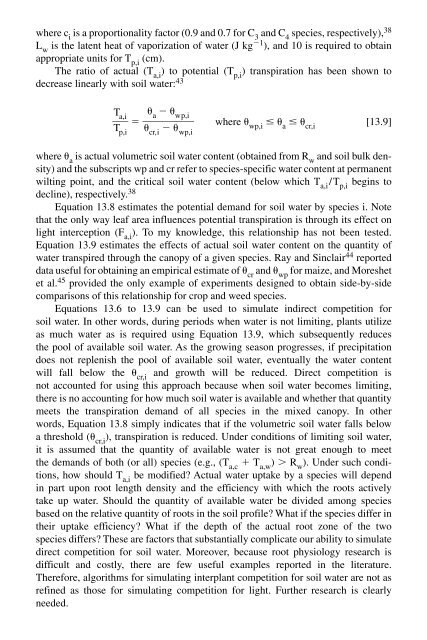Biotic Stress and Yield Loss
Biotic Stress and Yield Loss
Biotic Stress and Yield Loss
- No tags were found...
You also want an ePaper? Increase the reach of your titles
YUMPU automatically turns print PDFs into web optimized ePapers that Google loves.
where c iis a proportionality factor (0.9 <strong>and</strong> 0.7 for C 3<strong>and</strong> C 4species, respectively), 38L wis the latent heat of vaporization of water (J kg 1 ), <strong>and</strong> 10 is required to obtainappropriate units for T p,i(cm).The ratio of actual (T a,i) to potential (T p,i) transpiration has been shown todecrease linearly with soil water: 43T a, i a wp,i where Tp,i cr,i wp,i a cr,i[13.9]wp,iwhere ais actual volumetric soil water content (obtained from R w<strong>and</strong> soil bulk density)<strong>and</strong> the subscripts wp <strong>and</strong> cr refer to species-specific water content at permanentwilting point, <strong>and</strong> the critical soil water content (below which T a,i/T p,ibegins todecline), respectively. 38Equation 13.8 estimates the potential dem<strong>and</strong> for soil water by species i. Notethat the only way leaf area influences potential transpiration is through its effect onlight interception (F a,i). To my knowledge, this relationship has not been tested.Equation 13.9 estimates the effects of actual soil water content on the quantity ofwater transpired through the canopy of a given species. Ray <strong>and</strong> Sinclair 44 reporteddata useful for obtaining an empirical estimate of cr<strong>and</strong> wpfor maize, <strong>and</strong> Moreshetet al. 45 provided the only example of experiments designed to obtain side-by-sidecomparisons of this relationship for crop <strong>and</strong> weed species.Equations 13.6 to 13.9 can be used to simulate indirect competition forsoil water. In other words, during periods when water is not limiting, plants utilizeas much water as is required using Equation 13.9, which subsequently reducesthe pool of available soil water. As the growing season progresses, if precipitationdoes not replenish the pool of available soil water, eventually the water contentwill fall below the cr,i<strong>and</strong> growth will be reduced. Direct competition isnot accounted for using this approach because when soil water becomes limiting,there is no accounting for how much soil water is available <strong>and</strong> whether that quantitymeets the transpiration dem<strong>and</strong> of all species in the mixed canopy. In otherwords, Equation 13.8 simply indicates that if the volumetric soil water falls belowa threshold ( cr,i), transpiration is reduced. Under conditions of limiting soil water,it is assumed that the quantity of available water is not great enough to meetthe dem<strong>and</strong>s of both (or all) species (e.g., (T a,c T a,w) R w). Under such conditions,how should T a,ibe modified? Actual water uptake by a species will dependin part upon root length density <strong>and</strong> the efficiency with which the roots activelytake up water. Should the quantity of available water be divided among speciesbased on the relative quantity of roots in the soil profile? What if the species differ intheir uptake efficiency? What if the depth of the actual root zone of the twospecies differs? These are factors that substantially complicate our ability to simulatedirect competition for soil water. Moreover, because root physiology research isdifficult <strong>and</strong> costly, there are few useful examples reported in the literature.Therefore, algorithms for simulating interplant competition for soil water are not asrefined as those for simulating competition for light. Further research is clearlyneeded.

















